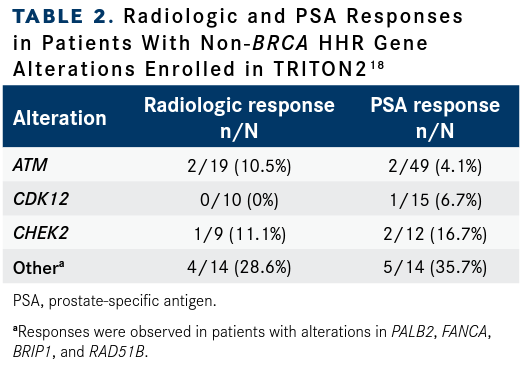Publication
Article
Oncology Live®
PARP Inhibitors in Metastatic Castration-Resistant Prostate Cancer: Whom to Treat?
Author(s):
PARP inhibitors have emerged as agents that generate improved oncological outcomes in select patient populations with metastatic castration-resistant prostate cancer.
Pedro C. Barata, MD, MSc

Despite the availability of numerous testosterone-suppressing treatments, including second-generation antiandrogens, and a trend toward treatment intensification earlier in the disease course (ie, castration-sensitive disease), an estimated 10% to 50% of prostate cancers progress to metastatic castration-resistant prostate cancer (mCRPC) within 3 years of diagnosis.1,2 Although mCRPC remains a lethal disease, several novel treatments associated with improved oncological outcomes have emerged, including poly PARP inhibitors—targeted agents that have been associated with improved oncological outcomes in certain patient populations, particularly those with BRCA alterations.
During a recent OncLive Peer Exchange®, a panel of genitourinary cancer experts provided an overview of currently available and emerging PARP inhibitors for mCRPC. They shared their insights on the clinical trials evaluating these agents as monotherapy and in combination with second-generation antiandrogen therapies. The combination approach in particular holds promise both for overcoming resistance mechanisms against PARP inhibitors and expanding these treatments to larger patient populations, including men with treatment-naïve mCRPC and those without BRCA or other gene alterations affecting DNA repair, according to the experts.
Over the past decade, PARP has emerged as a new target in cancer, with PARP inhibitors exploiting the deficiency of some cancer cells in repairing DNA double-strand breaks.3 PARP enzymes repair single-strand breaks in DNA, which enables cells to continue with their normal replication process.4 PARP inhibitors prevent repair of singlestrand breaks, causing these breaks to evolve into double-strand breaks. Although normal cells can fix double-strand breaks through the process of homologous recombinational repair (HRR), cells deficient in HRR are unable to fix these breaks, causing them to accumulate and resulting in cell death through apoptosis.4
“It seems today is relatively consensual that BRCA2 seems to be the strongest marker driving the signal [for PARP inhibitor efficacy],” Pedro C. Barata, MD, MSc, said.
Other relatively frequent alterations in DNA repair genes that have been identified in prostate cancer include ATM and BRCA1, with less commonly observed alterations including FANCA, RAD51B, RAD51C, MLH1, and MSH2, among others. It remains unclear what effect these other alterations may have on the efficacy of PARP inhibitors.5
Two PARP inhibitors have received FDA approval for mCRPC: olaparib (Lynparza) and rucaparib (Rubraca). These agents have slightly different indications, dosages, and adverse effect (AE) profiles (TABLE 16,7). Niraparib (Zejula) has received an FDA breakthrough therapy designation for mCRPC, and talazoparib (Talzenna) is a promising emerging PARP inhibitor for treating mCRPC.8

Olaparib Continues to Display Efficacy in mCRPC
Olaparib was the first PARP inhibitor to be approved by the FDA, with the initial indication granted for patients ovarian cancer in 2014, and the first drug targeting DNA damage response to enter the clinic.3 It received FDA approval in mCRPC in 2020 based on data from the phase 3 PROfound study (NCT02987543).9
In the PROfound study, patients with mCRPC were randomly assigned 2:1 to receive olaparib (n = 256) or physician’s choice of enzalutamide or abiraterone plus prednisone (n = 131).9,10 Patients were placed into 1 of 2 cohorts based on the presence of genetic alterations: cohort A, which included those with BRCA1, BRCA2, or ATM alterations (n = 245), and cohort B, which included those with alterations in any of 12 other prespecif ied genes (n = 142). In cohort A, 162 patients were treated with olaparib and 83 with physician’s choice of antiandrogen. In cohort B, 94 patients were treated with olaparib and 48 with physician’s choice of antiandrogen.
Olaparib was associated with improved imaging-based progression-free survival (PFS) and overall survival (OS).11,12 In cohort A, the median imaging-based PFS was 7.4 months in the olaparib arm vs 3.6 months in the control arm (HR, 0.34; 95% CI, 0.25-0.47; P < .001).12 The median OS in cohort A was 19.1 months with olaparib and 14.7 months with physician’s choice of antiandrogen (HR, 0.69; 95% CI, 0.50-0.97; P = .02).11 A benefit with olaparib was also observed in cohort B, with a median OS of 14.1 months vs 11.5 months with physician’s choice of antiandrogen. Overall, 86 of 131 patients in the control group (66%) crossed over to receive olaparib, including 56 patients (67%) in cohort A. When adjusting for crossover to olaparib, the HR for death was 0.42 in cohort A (95% CI, 0.19-0.91) and not statistically significant in cohort B.11
“Patients do way better in the context of biomarker disease and this is prechemotherapy,” Barata said.
Recently, quality of life (QOL) analyses from PROfound have reported olaparib to be associated with reduced pain burden and better health-related QOL compared with either enzalutamide or abiraterone. In cohort A, the median time to pain progression was not reached (NR) in the olaparib arm vs 9.92 months (95% CI 5.39-NR) in the control arm. In patients who had not used opiates at baseline, median time to first opiate use for cancer-related pain was 18 months in the olaparib arm vs 7.5 months in the control arm. Health-related QOL was assessed via Functional Assessment of Cancer Therapy-Prostate (FACT-P), which showed clinically meaningful improvement in FACT-P total score during treatment in the olaparib vs control arm, with 15 of 152 evaluable patients (10%) showing response in the olaparib arm vs 1 of 77 evaluable patients (1%) in the control arm.13
Additional data regarding olaparib from the phase 3 PROpel study (NCT03732820) were presented at the 2022 American Society of Clinical Oncology Annual Meeting.14,15 PROpel randomly assigned patients with mCRPC 1:1 to receive abiraterone plus prednisone/prednisolone plus olaparib 300 mg twice daily or placebo. A pharmacokinetics analysis found no clinically significant effect on the pharmacokinetic profiles of either olaparib or abiraterone when these agents were combined, with similar steady-state exposures between treatment arms, providing reassurance that these agents can be combined despite both drugs being metabolized by CYP3A4/5.14
Thus far, a median radiographic PFS (rPFS) of 24.8 months has been reported for abiraterone plus olaparib compared with 16.6 months for abiraterone plus placebo (HR, 0.66; 95% CI, 0.54-0.81; P < .0001).14 Safety analyses found the frequency and severity of AEs to be similar with the combination as when given individually.15 Anemia was the most frequent AE with the combination, which was typically managed by olaparib dose reductions or temporary cessation of treatment.15
“[PROpel] did not require the presence of a biomarker…. The results, in my opinion, are very striking because the benefit in terms of our PFS seems to be very good, clinically significant in my opinion, but it is interesting that if you look at the absence of a biomarker, we cannot say it’s a negative study there,” Barata said. He noted this finding needs to be validated in subsequent studies since other studies predominantly show benefit in the presence of certain biomarkers. “We need to settle the question: Do we need the biomarker for us to consider using a PARP inhibitor or [maybe] you don’t need that if you combine it with neoadjuvant hormonal therapy [NHT], in this situation abiraterone.”
Rucaparib Get Green Light in HRR-Mutant mCRPC
Rucaparib received accelerated FDA approval in May 2020 for patients with mCRPC based on data from the phase 2 TRITON2 trial (NCT02952534), a single-arm study that treated men with somatic or germline alterations in an HRR gene with rucaparib 600 mg twice daily.16,17 Among the 115 patients with a BRCA alteration with or without measurable disease, the objective response rate (ORR) was 43.5% (95% CI, 31.0%-56.7%) per independent radiology review, and 50.8% (95% CI, 38.1%-63.4%) per investigator assessment.17 The confirmed prostate-specific antigen (PSA) response rate was 54.8% (95% CI, 45.2%-64.1%).17
TRITON2 also included 78 patients with non-BRCA HRR gene alterations, including 49 with ATM, 15 with CDK12, and 12 with CHEK2 alterations. The findings in these patients suggest that some of the other fairly common HRR gene alterations found in mCRPC may not sensitize cells to PARP inhibition, as there were limited radiologic and PSA responses; however, patients who harbored some less frequently observed alterations in HRR genes, such as PALB2, were found to derive some benefit from PARP inhibition (TABLE 218).

“We’re waiting for data from the phase 3,” Barata said. “[TRITON2] shows that patients benefit from rucaparib. When we put all these data together again, [it supports] a biomarker-based approach.” In addition to the ongoing phase 3 TRITON3 study assessing rucaparib as a monotherapy (NCT02975934),19 rucaparib is being studied in combination with enzalutamide as a first-line treatment for mCRPC in the phase 3 CASPAR trial (NCT04455750).20
Niraparib Rapidly Moving Ahead in BRCA1/2-Mutated mCRPC
Niraparib received a breakthrough therapy designation from the FDA in October 2019 as a treatment for patients with BRCA1/2-mutated mCRPC who have been previously treated with taxane chemotherapy and androgen receptor-targeted therapy.8 The designation was based on data from the phase 2 GALAHAD study (NCT02854436), which showed an ORR of 34.2% (95% CI, 23.7%-46.0%) among heavily pretreated men harboring tumors with BRCA alterations.21 Niraparib is currently being studied in the phase 3 MAGNITUDE trial (NCT03748641) as a first-line combination therapy with abiraterone acetate plus prednisone in men with mCRPC with or without HRR gene alterations.22
“Treatment in biomarker-negative [patients in the MAGNITUDE trial] was stopped for fertility, which made sense based on what we learned so far, but when we look in the biomarker-positive [patients], the combination of an NHT with niraparib was promising,” Barata said. In patients with HRR gene alterations, the combination has thus far shown benefit in rPFS, ORR, time to initiation of cytotoxic chemotherapy, time to symptomatic progression, and time to PSA progression.22 Barata said OS data are anticipated.
Talazoparib Looks to Build Off Positive Results in Breast Cancer
Talazoparib, which is currently FDA approved for metastatic breast cancer, is being studied for mCRPC in the phase 3 TALAPRO-2 study (NCT03395197).23,24 TALAPRO-2 is comparing rPFS between talazoparib plus enzalutamide and enzalutamide plus placebo in men with and without tumors harboring DNA damage response (DDR) alterations. There are over 20 secondary outcome measures, including OS and ORR.23,24
Administering PARP Inhibitors in mCRPC Requires Careful Discretion
A key question that remains is whether PARP inhibitors have a role in treating patients without tumors harboring DDR alterations, especially since there have been some data showing beneficial effect in such populations.
“PARP inhibitors have other functions and they do impact downstream expression of antigen-regulated genes. There’s a scientific rationale [for using them],” Tanya B. Dorff, MD, said. She noted, however, that more studies will be needed before a definitive determination can be made because the current data are difficult to apply to real-world populations. “Most of our patients who have CRPC will have been exposed to an androgen receptor (AR)-targeted agent up front. And then do they fit into the data set?” she asked.
Mary-Ellen Taplin, MD, also posed the question of whether the PROpel study allowing liquid biopsies to assess for DDR alterations may have led to some patients being misclassified because of deletions being missed. Andrew J. Armstrong, MD, MSc, a PROpel investigator, noted that while this is possible, he said it is unlikely that a large proportion of patients were misclassified.
“There could have been a few BRCA patients that have homologous homozygous deficiencylike deletions that are missed because there’s so much wild-type DNA there…But that’s going to be probably less than 1% or 2%. I don’t think that’s driving the wild-type outcomes,” Armstrong said.
Although it is clear additional studies will be needed before PARP inhibitors can be extended to broader patient populations with mCRPC, even patients who are clear candidates for these agents may not be receiving them.
“Data suggest that most patients get an NHT followed by still another NHT. Some are getting chemotherapy,” Barata said. However, he anticipates that there will be an uptick in use of PARP inhibitors and other effective therapies, especially as the data continue to evolve.
References
- Maurice Dror C, Chi KN, Khalaf DJ. Finding the optimal treatment sequence in metastatic castration-resistant prostate cancer-a narrative review. Transl Androl Urol. 2021;10(10):3931-3945. doi:10.21037/ tau-20-1341
- Akaza H, Procopio G, Pripatnanont C, et al. Metastatic castration-resistant prostate cancer previously treated with docetaxel-based chemotherapy: treatment patterns from the PROXIMA prospective registry. J Global Oncol. 2018;4:1-12. doi:10.1200/JGO.18.00009
- Slade D. PARP and PARG inhibitors in cancer treatment. Genes Dev. 2020;34(5-6):360-394. doi:10.1101/gad.334516.119
- Sonnenblick A, de Azambuja E, Azim HA Jr, Piccart M. An update on PARP inhibitors--moving to the adjuvant setting. Nat Rev Clin Oncol. 2015;12(1):27-41. doi:10.1038/nrclinonc.2014.163
- Robinson D, Van Allen EM, Wu YM, et al. Integrative clinical genomics of advanced prostate cancer. Cell. 2015;161(5):12151228. Published correction in Cell. 2015;162(2):454.
- Lynparza. Prescribing information. AstraZeneca; 2022. Accessed September 27, 2022. bit.ly/3CiIpgh
- Rubraca. Prescribing information. Clovis Oncology, Inc; 2022. Accessed September 27, 2022. bit.ly/3feCKhZ
- Janssen announces U.S. FDA breakthrough therapy designation granted for niraparib for the treatment of metastatic castration-resistant prostate cancer. News release. Johnson & Johnson. October 3, 2019. Accessed September 27, 2022. bit.ly/3SEnvNT
- FDA approves olaparib for HRR gene-mutated metastatic castration-resistant prostate cancer. FDA. May 19, 2020. Accessed September 27, 2022. bit.ly/3SG2wdo
- Hussain M, Mateo J, Fizazi K, et al. PROfound: Phase 3 study of olaparib versus enzalutamide or abiraterone for metastatic castration-resistant prostate cancer (mCRPC) with homologous recombination repair (HRR) gene alterations. Ann Oncol. 2019;30(suppl 5):v851-v934. doi:10.1093/annonc/mdz394
- Hussain M, Mateo J, Fizazi K, et al. Survival with olaparib in metastatic castration-resistant prostate cancer. N Engl J Med. 2020;383(24):2345-2357. doi:10.1056/NEJMoa2022485
- de Bono J, Mateo J, Fizazi K, et al. Olaparib for metastatic castration-resistant prostate cancer. N Engl J Med. 2020;382(22):20912102. doi:10.1056/NEJMoa1911440
- Thiery-Vuillemin A, de Bono J, Hussain M, et al. Pain and health-related quality of life with olaparib versus physician’s choice of next-generation hormonal drug in patients with metastatic castration-resistant prostate cancer with homologous recombination repair gene alterations (PROfound): an open-label, randomised, phase 3 trial. Lancet Oncol. 2022;23(3):393-405. Published correction in Lancet Oncol. 2022;23(4):e161.
- Armstrong AJ, Clarke N, Thiery-Vuillemin A, et al. Olaparib plus abiraterone as first-line therapy in men with metastatic castration-resistant prostate cancer: pharmacokinetics data from the PROpel trial. J Clin Oncol. 2022;40(suppl 16):5050. doi:10.1200/ JCO.2022.40.16_suppl.5050
- Thiery-Vuillemin A, Saad F, Armstrong AJ, et al. Tolerability of abiraterone (abi) combined with olaparib (ola) in patients (pts) with metastatic castration-resistant prostate cancer (mCRPC): further results from the phase III PROpel trial. J Clin Oncol. 2022;40(suppl 16):5019. doi:10.1200/JCO.2022.40.16_suppl.5019
- FDA grants accelerated approval to rucaparib for BRCA-mutated metastatic castration-resistant prostate cancer. FDA. May 15, 2020. Accessed September 27, 2022. bit.ly/3ChwYoW
- Abida W, Patnaik A, Campbell D, et al. Rucaparib in men with metastatic castration-resistant prostate cancer harboring a BRCA1 or BRCA2 gene alteration. J Clin Oncol. 2020;38(32):3763-3772. doi:10.1200/JCO.20.01035
- Abida W, Campbell D, Patnaik A, et al. Non-BRCA DNA damage repair gene alterations and response to the PARP inhibitor rucaparib in metastatic castration-resistant prostate cancer: analysis from the phase II TRITON2 study. Clin Cancer Res. 2020;26(11):24872496. doi:10.1158/1078-0432.CCR-20-0394
- A study of rucaparib versus physician’s choice of therapy in patients with metastatic castration-resistant prostate cancer and homologous recombination gene deficiency (TRITON3). ClinicalTrials.gov. Updated March 24, 2022. Accessed September 28, 2022. https://clinicaltrials.gov/ct2/show/NCT02975934
- A clinical study evaluating the benefit of adding rucaparib to enzalutamide for men with metastatic prostate cancer that has become resistant to testosterone-deprivation therapy (CASPAR). ClinicalTrials.gov. Updated September 27, 2022. Accessed September 28, 2022. https://clinicaltrials.gov/ct2/show/NCT04455750
- Smith MR, Scher HI, Sandhu S, et al. Niraparib in patients with metastatic castration-resistant prostate cancer and DNA repair gene defects (GALAHAD): a multicentre, open-label, phase 2 trial. Lancet Oncol. 2022;23(3):362-373. doi:10.1016/S14702045(21)00757-9
- Chi KN, Rathkopf DE, Smith MR, et al. Phase 3 MAGNITUDE study: first results of niraparib (NIRA) with abiraterone acetate and prednisone (AAP) as first-line therapy in patients (pts) with metastatic castration-resistant prostate cancer (mCRPC) with and without homologous recombination repair (HRR) gene alterations. J Clin Oncol. 2022;40(suppl 6):12. doi:10.1200/JCO.2022.40.6_ suppl.012
- Talazoparib + enzalutamide vs. enzalutamide monotherapy in mCRPC (TALAPRO-2). ClinicalTrials.gov. Updated August 5, 2022. Accessed September 28, 2022. https://clinicaltrials.gov/ct2/ show/NCT03395197
- Agarwal N, Azad A, Shore ND, et al. Talazoparib plus enzalutamide in metastatic castration-resistant prostate cancer: TALAPRO-2 phase III study design. Future Oncol. 2022;18(4):425-436. doi:10.2217/fon-2021-0811























%20(2)%201-Recovered-Recovered-Recovered-Recovered-Recovered-Recovered-Recovered-Recovered-Recovered-Recovered-Recovered-Recovered-Recovered-Recovered-Recovered-Recovered-Recovered.jpg?fit=crop&auto=format)
%20(2)%201-Recovered-Recovered-Recovered-Recovered-Recovered-Recovered-Recovered-Recovered-Recovered-Recovered-Recovered-Recovered-Recovered-Recovered-Recovered-Recovered-Recovered.jpg?fit=crop&auto=format)
